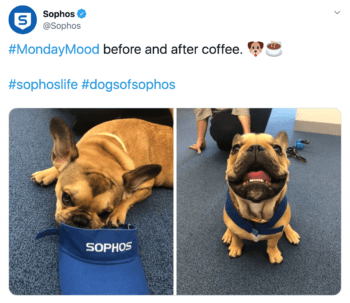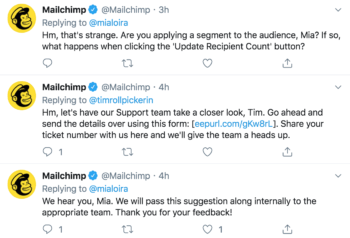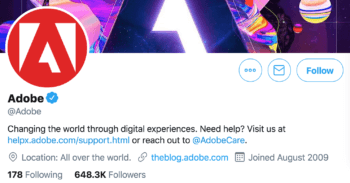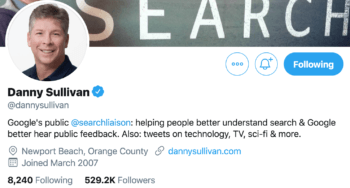There’s so much more to Twitter for B2B brands than simply retweeting the news and posting blog content. Take full advantage of your efforts on Twitter with a content-channel fit that gets your B2B brand results.
B2B brands know you’re not going to sell a product with one tweet. You’re playing the long game with your digital marketing, which means adding value at every stage of the funnel. This way, when it’s time to look for a business solution, your brand is top of mind as a valuable expert.
Acting as your company, it’s important to weigh in on relevant conversations with valuable (and on-brand!) tips and resources. When you curate your brand’s feed with relevant news, competitors, client industry leaders, and big names in your circle, your response opportunities are easier to find. Conversation and reciprocity from your brand establish your company as an authority figure on your subject, plus it incentivizes people to follow you for good advice.
Aside from adding value with the links, photos, and tweets you send, consider elevating your approach to Twitter with the advice and examples we’ve rounded up.
Suss out your Twitter strategy
Twitter is a great place to glean what competitors are up to lately. Not only can you track their analytics with powerful tools, but you can also advance your social listening strategy by following counterparts in your industry. Keep an eye on engagement, RTs, and the types of interaction brand handles are using.
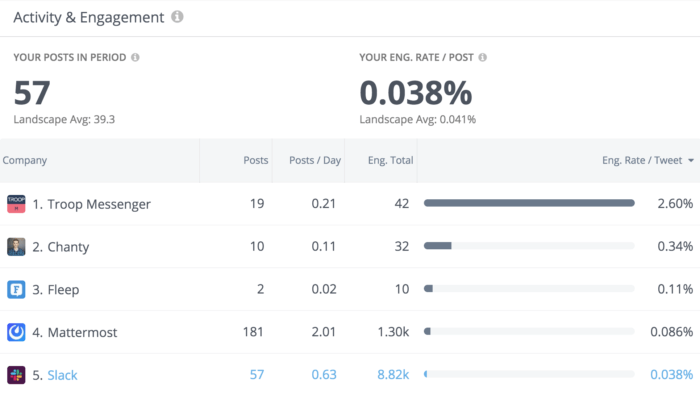
For instance, Slack has the homecourt-office-chat advantage, but newcomer Troop Messenger is seeing a high engagement rate on Twitter. It’d be worthwhile for competitors to dig into why.
A dedicated competitive analysis should leave you with a breakdown of what Twitter strategy your competition is aiming for, and how it’s performing. Social media competitive analysis, particularly on Twitter, opens up excellent strategy opportunities and helps you set realistic goals based on your competitive landscape. Competitive analysis on Twitter will show you that most B2B brands trend toward one of the following content strategies:
The blog regurgitation:
Brands will churn out their blog and product content with an automated RSS feed or a social media marketer. In a perfect world, the brand will use copy that’s specific to their Twitter audience to make their content stand out in a feed. Brands looking for engagement metrics can tag authors, stakeholders, or other brands to invite retweets and a broader reach.
Another way to make this strategy stand out is to use custom graphics in your Twitter posts. The default imaging on Twitter for link sharing is dated and poorly designed, so adding a shiny graphic or title card will incentivize more clicks.
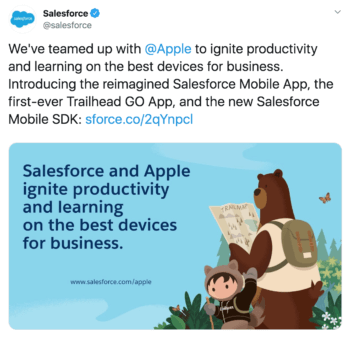
Salesforce is succeeding when it comes to recognizable branded content. See their product offering tweet above with a tag to Apple and a custom image. Nice.
The inside-look:
This strategy is common for B2B brands looking to hire. The behind-the-scenes posts on Twitter can get some nice engagement rates and humanize your company. Tagging current employees, your leadership, and locations can be a nice way to boost interaction.
One problem with this strategy is that it often attracts people who want to work for your company or have a stake in the game. It’s a way to pigeonhole your content on Twitter towards one goal and if you’re looking to repurpose in the future it can be a tough transition since you’ve curated a very specific following.
The personified brand:
Think of brands like Wendy’s, Denny’s, and thousands more getting plucky on Twitter. Vulture breaks down some of the best and worst examples in this evolution of corporate social media timeline. This strategy can pay off and create a cult following of brand advocates. Or, it can be poorly executed, off-color, and offensive, potentially ostracizing your following. Highly popularized by B2C brands, it’s important for B2B brands to remember that a smaller niche market means less virality potential.
The key to making this strategy a success is twofold: knowing your audience and putting in the effort. This requires an in-depth analysis of what tone resonates with your target demographic and how to execute it in a tasteful and interesting way. This plan also needs a dedicated social team with a crystal clear brand voice.
Which Twitter strategy is for you?
The best Twitter strategy combines the elements of each of these main strategies. A winning brand handle will tweet engaging content and images with a branded feel, plus humanize the company with some behind-the-scenes content. And what would Twitter be without some plucky wit? Just remember to keep it on-brand and don’t try too hard to be the next viral handle.
Juggling help questions on Twitter
It’s futile to delve into B2B Twitter marketing without noting the part of Twitter that takes up the most of your team’s time and energy: community management.
Go to any B2B Twitter handle under “Tweets and Replies” and you’ll see countless support questions, reviews, and a whole lot of customer emotions.
The simple fact is that when it comes to a quick company reply, Twitter gets the job done. It’s a necessary evil for any brand in the modern age but it can derail your strategic plans for a curated feed. Twitter lays out their top tips for engaging with customers from your handle, but our favorite solution is a separate handle which many brands use to help sort out the noise and give customer success or community managers a direct line to clients.
Putting your best face forward
For B2B brands to take full advantage of Twitter’s wide and varied demographic, it’s a good idea to have a brand advocate working towards your goal. This could be your leadership, a customer-facing employee, or even an external influencer. Having a personal Twitter account speak on behalf of your brand opens a lot of doors that a brand handle alone is unlikely to push through.
Your brand advocate should be following key clients, potential clients, journalists in your industry, and even competitors. Your Twitter following should see this person as the go-to for questions, quotes, and opinions on what’s happening in your field. A great example here is Danny Sullivan, Google’s Search Liaison, who is the best person to follow for algorithm updates and humanizing Google’s Search products.
While it’s unlikely your brand is as large as Google, you can definitely learn a thing or two about how the brand leverages this personal account to interpret their complicated product offering.
Your brand advocate doesn’t just help customers and potential clients–their direct outreach can be instrumental in reaching big names, journalists, and partners. When business contacts refer to their Twitter profile, they’ll see a real person who is an authority figure on your brand instead of a robotic company voice.
The toughest part of using this tried-and-true business development strategy is choosing a brand advocate that has a good balance of personal and professional and is a good long-term fit. There’s nothing worse than trying to redevelop this brand authority figure every two years after employee turnover. You want a loyal stakeholder who personifies your brand and is invested for the long haul. Most startups and smaller businesses use the business owner or CEO as this figurehead, which is great as long as they can put in the hefty time investment required to make this work.
Here’s a mini checklist of what your brand advocate should be doing:
- Link back to your site or brand handle in their bio
- Open up a bit about life and work
- Promote product updates, big events, exciting learnings in the company
- Stay on-brand–no hardline opinions unless they’re something the company would stand behind
- Be themselves, showing personality is important to make cold connections
- Weigh in on industry news with personal insights and opinions
- Follow and use relevant hashtags to expand your brand’s reach
- Make sure their Twitter is public
- Share knowledge–they’re the expert!
Incorporating this thought leadership into your brand’s strategy can increase the return you get from Twitter marketing. Business development doesn’t happen overnight–you have to regularly put in quality content to reap the benefits of being a well-known subject expert.
Flying the coop
Investing your time and a curated strategy into Twitter content and outreach to articulate your product offering, brand voice, and subject expertise can turn this noisy social platform into a valuable brand asset. Set your B2B handle apart from the competition with a Twitter page that’s adding value to all of your followers, from the casual observer to your existing clients.
B2B brands should track Twitter analytics at every stage to keep an eye on overall impact. Determine the company’s goals for Twitter, craft a strategy that works well for the brand’s industry and objectives, and consider putting an external-facing brand advocate at the forefront of customer interaction. Your brand can add a lot of value with 280 characters!
As a fellow B2B company on Twitter, we love interacting with our readers. Tweet us your thoughts or share tips on your Twitter strategy when you mention @RivalIQ.

